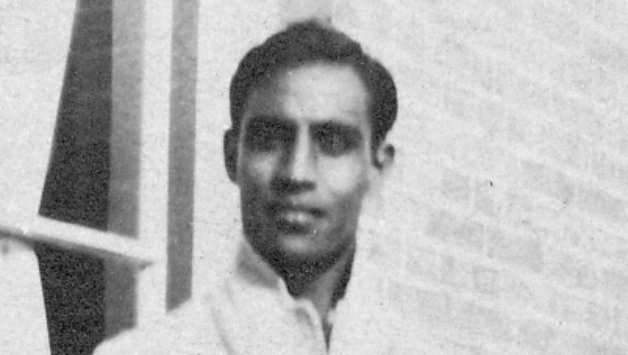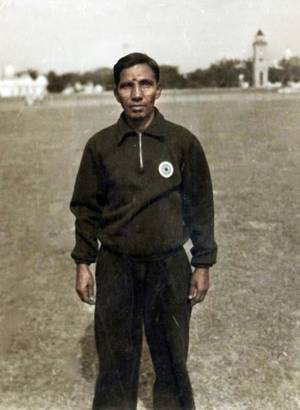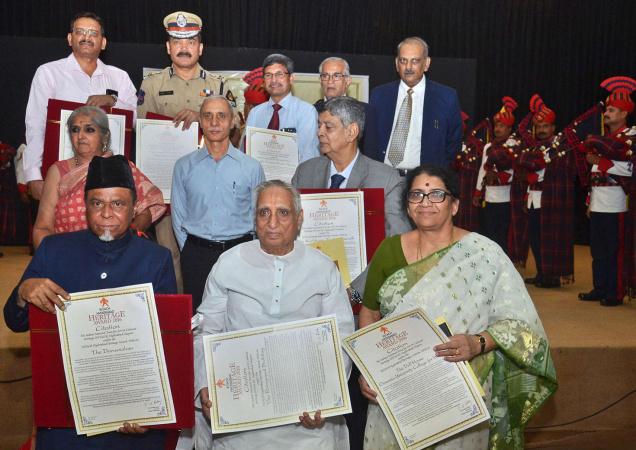Hyderabad, TELANGANA :
Syed Mohammad Hadi was nicknamed Rainbow for his prowess in cricket, tennis, field hockey, football, table-tennis, chess, and polo.

One of the main issues under discussion during the July 1934 meeting of BCCI, held in Bombay, was a detailed discussion regarding the introduction of a nation-wide First-Class cricket competition, where teams representing the different local cricket associations of the nation would participate to ultimately determine the national champion. It was founded as “The Cricket Championship of India”. The tournament kicked off in 1934-35. The handsome trophy was donated by His Highness Sir Bhupinder Singh, Maharaja of Patiala, in memory of Ranji to cricket lovers all over the world.
As all students of Indian First-Class cricket history are aware, the very first Ranji Trophy match of all, between Madras and Mysore at Madras on November 4, 1934 turned out to be a bit of a letdown, the whole match being completed in one day. It remains the first of only 2 First-Class matches played in India to be completed in a day till date (the second being Saurashtra vs Baroda at Rajkot on December 5, 1959).
This match will forever be remembered for the wonderful bowling performance that resulted in a match of such short duration, 6 for 19 (out of total of 48) and 5 for 16 (out of 59) by the doyen of Madras cricket at the time, the great left-handed all-rounder, AG Ram Singh, patriarch of the first family of contemporary Madras cricket.
Perhaps a little overshadowed by AG Ram Singh was a right arm medium-pace and off-break bowler from the Mysore team, appropriately named Mysore Vijayasarathi, who picked up 6 for 23 in the only Madras innings of 130. Vijayasarathi would later cause a flutter among lovers of cricket trivia by umpiring a Ranji Trophy match between Mysore and Andhra in Dec/1960 at Bangalore along with his son, MV Nagendra.
The sad but undeniable fact was that there were no outstanding batting performances in the first two Ranji Trophy matches played.
The third Ranji Trophy match of the inaugural season began on the Friday, November 23, at Secunderabad. Hosts Hyderabad, led by Syed Mohamad Hussain, were taking on the Madras team, led by M Venkataramanjulu.
The hosts won the toss and decided to take strike. They reached a competitive score of 256 in their 1st innings, captain SM Hussain top-scoring with 80 and F Toorkey, opening the innings, making 72 runs. As if it were pre-ordained, Ram Singh captured 5 for 88. The Madras 1st innings finished at 301, with only Ram Singh (74) and Cotar Ramaswami (61) reaching double figures.
The Hyderabad 2nd innings was in disarray when the 3rd wicket fell at the team score of 12. Syed Mohammad Hadi then arrived at the crease to take strike. He scored 132 not out in his team’s score of 227, becoming the first ever centurion in Ranji Trophy cricket. This match was his Ranji Trophy debut match as well, and this century his maiden First-Class century.
In a surprising turn of events, the visitors were dismissed for 169 in their 2nd innings. That man Ram Singh (70) scored another half-century and MJ Gopalan made 58. The man who wrecked the Madras 2nd innings was one Tata Rao (8 for 73), and Hyderabad won by 13 runs.
Born August 12, 1899 in India, Hadi was a right-hand batsman who has no record of ever bowling in this format of cricket. In a span of 1930-31 to 1940-41, SM Hadi played 24 First-Class matches aggregating 1,043 runs with a highest of 132 not out (as mentioned above) and an average of 32.59. He was to later score another century and 3 fifties, and to take 9 catches.
Hadi’s profile informs us that his father Captain Syed Mohammed, erstwhile officer in army of Hyderabad state, had passed away when Hadi was just about two years of age. Hadi’s subsequent upbringing was through the support and supervision of the family of Sir Asman Jah, former Prime Minister in the court of the Nizam of Hyderabad.
He was brought up alongside the son of Sir Jah, Nawab Moin-ud-Dowlah, after whom the famous cricket tournament was to be named and who would become a famous patron of the sports of the region. Hadi had the opportunity of learning horse riding as a youngster and was sufficiently good at soccer to play for Nizam College. In view of the boy’s obvious aptitude for a number of sports, the family of Sir Jah decided to send him over to England to continue his studies.
In the newsletter VARSITY, dated June 12, 2016 from Cambridge is an article by Matt Worth, in which he comments, “The wardrobe in his room at Peterhouse must have been bursting with light blue jackets, as he shone at polo, tennis, soccer, field hockey, cricket and table tennis. A particularly fine tennis player, it is at the racket game that his sporting career perhaps hit its greatest heights, as he played at Wimbledon five times, reaching the doubles quarter final in 1926. He also represented India at the 1924 summer Olympics and in the Davis Cups of 1925 and 1926. The run of representative appearances for his country must have more than made up for his frustration at being denied the Light Blues’ tennis captaincy on account of his nationality.” He had an MA from Cambridge and a Masters from the University of Pennsylvania.
Hadi made his First-Class debut for Hyderabad against Maharaj Kumar of Vizianagram’s XI in the Moin-ud-Dowlah Gold Cup semi-final of 1930-31, played at Secunderabad in 1930-31, under the leadership of wicketkeeper SM Hussain, who was also keeping wickets.
He was well past the age of 30 at that time, and scored 17 and 42 not out against a team captained by Jack Hobbs, and for whom Herbert Sutcliffe scored 165 in the side’s only innings of 329. Hyderabad managed totals of 265 and 194 in a drawn match that was awarded to the visiting team on the basis of their 1st-innings lead.
It may be mentioned here that Hyderabad batted against the bowling of the brothers CK and Cs Nayudu and Ghulam Mohammad, among others. An interesting sidelight of this match was the fact that while Naoomal Jaoomal kept wickets in the home team’s first innings, he not only bowled but took 2 for 7 from his 3 overs while one P Shankerdas, who was not in the playing eleven for the visiting team, was allowed to keep wickets as a substitute.
In the Ranji Trophy clash with Madras at Chepauk in December 1935, Hadi, captaining the Hyderabad team, scored 85 and 0 in a match that Madras won by 6 wickets, Ram Singh being the undisputed hero of the match, scoring 121 and 57, both not out, and taking 2 for 77 and 6 for 32.
It was at Chepauk in February 1936 that India took on an Australian team in an “unofficial Test”. The home team was led by Wazir Ali and included luminaries like Kartick Bose, Mushtaq Ali, Lala Amarnath, Amar Singh, Ram Singh, Hadi and Mohammad Nissar. The Australian team was led by the ageing Jack Ryder and included, among others, ‘Stork’ Hendry, ‘Hammy’ Love (though he did not keep wickets in this match), and the one and only ‘Governor-General’ — Charlie Macartney.
India batted first and put up 189, thanks to 45 by Amar Singh and 43 by Mushtaq Ali. Macartney took 3 for 52. The Australian 1st innings ended at 162, with a good 48 from Fred Mair. Nissar (5 for 61) and Amar Singh (5 for 54) shared the wickets.
India managed only 113 in their 2nd knock, the top-scorer being Hadi with 19 not out (he had also made 19 not out in the 1st innings). Once again, it was Macartney among the wickets with 6 for 41.
The Australian 2nd innings was an even feebler effort — 107, with the only worthwhile score being 41 by captain Jack Ryder. Nissar (6 for 36) and Amar Singh (2 for 54) ensured an Indian victory by 33 runs. It must be said, however, that for the visitors, Hendry, Ryder, Love, wicketkeeper John Ellis, Macartney, Joe Davis, and Harry Alexander were past their prime and playing their last First-Class match. For the home team, Wazir Ali completed 1,000 First-Class runs for the season, and Hadi completed 500 career First-Class runs.
It was against the old foes, Madras again, that Hadi scored his other First-Class century, in the Ranji Trophy match at Secunderabad in December 1939, with a score of 106 (his 100 coming in 120 minutes) in a total of 443. Hyderabad batted only once in a match and won by an innings and 2 runs. Ram Singh, however, had still not finished with them, capturing 5 for 136 and scoring a solid 44 in the Madras 1st innings of 262. When he had scored 81, in this match, Hadi completed 1,000 First-Class runs.
His final First-Class match, again against Madras, was at Chepauk in December 1940. As captain of Hyderabad, his contributions were 2 (out of 98) and 16 (out of 132). Ram Singh, perennial nemesis of the team, turned in another stellar performance with 27 and 53, and picked up 6 for 30 and 4 for 26, as Madras won by 254 runs.
Retirement from his active playing days did not diminish his interest in sports. Along with his step-brother, Col. Ali Raza and with Nawab Mahmood Yar Jung, SA Rahim and Ahmed Mohiuddin, Hadi founded the Hyderabad Cricket Association and Hyderabad Football Association in 1934, with himself as the first Secretary.
He became the Director of Physical Education in Hyderabad and later, Joint Secretary of Education of the Indian Government. He was National Commissioner of Boy Scouts of India and, when the All-India National Council of Sports was founded in 1959, he was the first Secretary. The runners-up trophy of the Mon-ud-Dowlah Gold Cup tournament is now called the SM Hadi Memorial Trophy.
This multidisciplinary sportsman died in his native Hyderabad on July 14, 1971 of lung cancer. For his extraordinary skill at the seven sports of cricket, tennis, field hockey, football, table-tennis, chess, and polo, SM Hadi is fondly remembered by all Indian lovers of sport as ‘Rainbow’ Hadi.
(Pradip Dhole is a retired medical doctor with a life-long interest in cricket history and statistics)
source: http://www.cricketcountry.com / Cricket Country / Home> English> Features> Moments in History / by Pradip Dhole / June 16th, 2016










